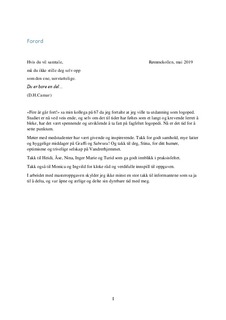| dc.contributor.advisor | Norvik, Monica | |
| dc.contributor.advisor | Røste, Ingvild | |
| dc.contributor.author | Grimdalen, Marit Mo | |
| dc.date.accessioned | 2019-09-19T14:01:32Z | |
| dc.date.available | 2019-09-19T14:01:32Z | |
| dc.date.issued | 2019 | |
| dc.identifier.uri | http://hdl.handle.net/11250/2617784 | |
| dc.description.abstract | Tema i denne masteroppgaven er dysfagi knyttet opp mot den geriatriske slagpasient og hvordan helsepersonell opplever det tverrfaglige samarbeidet rundt pasientgruppen. Faggrupper som kan være involvert i arbeidet rundt dysfagi skisseres, og jeg ser på forholdet som berører sømløse overganger mellom 1. og 2. linjetjenesten, og hvordan det samarbeides.
Jeg ser på hva som kjennetegner en tverrfaglig tilnærming, og forholdet mellom teoretisk kunnskap og praktisk kunnskap med utgangspunkt i et sosiokulturelt syn. Empirien fortolkes ikke primært ut fra en bestemt teoretiker eller teori, men funn blir belyst og sett i sammenheng med Nonoaka og Takeuchi sin modell for taus og eksplisitt kunnskap, og Liv Helene Jensens modell om Kunnskapsbasert praksis.
Det kvalitative forskningsintervju er benyttet som metode, for å besvare forskningsspørsmålet der informantenes opplevelse er det sentrale. Empiri er avgrenset til tre fokusintervjuer med to deltakere i hvert av dem. Utvalget ble begrenset til helsepersonell som i utgangspunktet hadde erfaring og kunnskap både klinisk og teoretisk med dysfagi. Dette er valgt for å oppnå den mest effektive form for datagenerering, gi trygghet til deltakerne og skape rammer for interaksjon og en spontanitet i intervjusituasjonen. For å utvide kunnskapen min og få svar på forskningsspørsmålet, er metoden stegvis deduktiv-induktiv – metode benyttet (A. H. Tjora, 2018). Materialet som fremkom ble transkribert, og er utgangspunkt for drøftingen av resultatene.
Resultatene kan peke i retning av at ulike rammer har innvirkning på hvordan arbeidet med dysfagi blir håndtert, og i hvilken grad informantene opplever en tverrfaglig tilnærming til pasientene med dysfagi. Det finnes kunnskap om dysfagi i 1. og 2. linjetjenesten, både taus og eksplisitt, dog i varierende grad. Tverrfaglig tilnærming til dysfagi synes å bli bedre ivaretatt der rehabilitering er en uttalt målsetning for institusjonen. | |
| dc.description.abstract | The main subject in this thesis is dysphagia linked to geriatric stroke patients. How does the Health Personnel experience interdisciplinary cooperation with this group of patient. Professions that may be involved in the work on dysphagia are outlined, and I look at the relationship that affects seamless transitions between the 1st and 2 line services, and how they work together.
I look at what characterizes an interdisciplinary approach, and the relationship between theoretical knowledge and practical knowledge based on a socio-cultural view. The empire is not primarily interpreted from a specific theorist or theory, but findings are illuminated and seen in the context of Nonoaka and Takeuchi's model for silent and explicit knowledge, and Liv Helene Jensen's model on Knowledge-based practice.
The study is based on a qualitative design. The material is built on findings from three focus interviews with two participants in each of them. The qualitative research interview is used as a method, to answer the research question where the informants' experience is central. It was limited to a one hour period per interview, and one interview was made with each group. The group of informants were limited to health personnel who initially had experience and knowledge both clinically and theoretically with dysphagia. This has been chosen to achieve the most effective form of data generation, providing security to the participants and creating a framework for interaction and spontaneity in the interview situation. Focus group interviews were analysed by a stepwise deductive-inductive method. The material that came out was transcribed, and is the basis for the discussion of the results.
The results may point to the fact that different kinds of frameworks frames have an impact on how the work with dysphagia is in focus, and to what extent the informants experience an interdisciplinary approach to the patients with dysphagia. There is knowledge of dysphagia in all three institutions included in the study, both formal and tacit, though to varying degrees, and interdisciplinary approach to dysphagia is more focused on where rehabilitation is a stated goal for the institution. | |
| dc.language | nob | |
| dc.publisher | NTNU | |
| dc.title | Fra tallerken til magesekk - Tverrfaglig samarbeid rundt dysfagi til pasientens beste | |
| dc.type | Master thesis | |
